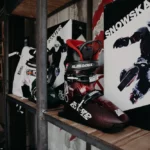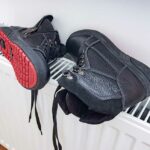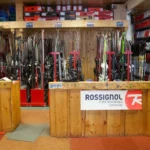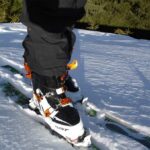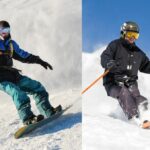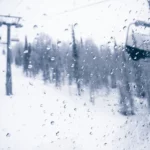Skiing and prescription glasses - that doesn’t seem like a match made in heaven at first glance. When you’re out on the slopes you’ve got a lot of conditions to contend with like extremely bright sunlight, snow, and wind.
You need goggles, or at the very least when the weather is good some wraparound shades for UV protection. Also, what happens if you take a spill? You don’t want to add the cost of a new set of glasses to your ski trip.

You want to be able to see clearly out there, so what do you do? Happily, there is a range of ways you can wear your glasses and have a great time on the slopes. We’re going to go through them below, along with some of the common issues you might face, so you can ski with confidence.
OTG Goggles
The first port of call for anyone looking to ski with their prescription glasses should be to investigate over-the-glasses (OTG) goggles. These are goggles that are specifically designed to fit over your glasses (as the name suggests).
They extend out further from the face than regular skiing goggles, but still maintain that all-important seal to prevent fogging and stop powder getting in.
Make sure you’re not just looking at big goggles rather than OTG goggles. You might get lucky with simply sizing up a regular pair of goggles, but they won’t have been designed to accommodate your glasses in the same way as a proper pair of OTG goggles.
OTG models are designed to be wider to fit the projection of the temple of a pair of glasses, whereas the tighter profile of regular goggles doesn’t allow for this. Regular goggles are built to fit your natural face snugly, after all!
OTG goggles offer all of the protection regular goggles do, but with the added benefit of letting you wear your glasses underneath. This means that all of the options available to you when you are shopping for regular goggles still apply.
You can buy OTG goggles in any level of tint, with reflective coatings, even with ventilation to help prevent fogging.
OTG goggles are a common solution for anyone participating in winter sports who wears glasses, and most big manufacturers make OTG options, so you have no shortage of choices.
Touching upon fogging briefly, this is an issue that some people do encounter with OTG goggles.
Given that fogging is a problem for regular goggles anyway, it makes sense that with two sets of glass in a sealed compartment you run the risk of not only your goggles fogging up, but your glasses too.
As previously mentioned, some OTG goggles are vented to help prevent this, but the main enemy with fogging is dirty glass.
Water vapour condenses around specks of dirt, so make sure that your goggles and your glasses are both spotlessly clean (using an appropriate cleaner so as not to damage the anti-fog coating of your goggles) before you suit up.
Prescription Inserts
Almost a halfway house between regular goggles and OTG goggles, prescription inserts are a smart way to get your prescription lenses into your goggles.
Effectively a modified glasses frame that sits within the aperture of a pair of regular goggles, prescription inserts can be tailored to suit your needs exactly. You can buy specific inserts for most manufacturers’ goggles, and universal inserts are also available.
Check the compatibility of universal inserts before you buy them, as they are not quite as universal as the name suggests. Retailers will list which goggles the inserts are compatible with, and suggest alternatives if your goggles are not among them.
Prescription inserts can have lenses with a variety of coatings to help with fogging and durability, and can even be purchased as bifocals to help with reading piste maps. Simply select your options and you’ll be away.
Because prescription inserts fit into the front of your goggles and are larger than regular glasses lenses they offer you a fantastic field of view at your prescription, and aren’t as prone to fogging as a regular pair of glasses which sit closer to your face and trap moisture immediately as it rises from your skin.
One downside of prescription inserts is that, unless you are carrying a pair of glasses with you, once you take your goggles off you also lose your corrected vision.
This is something that a lot of people find quite unappealing and which also applies to helmets with prescription visors or prescription goggles which, being hard to come by and relatively impractical, are not covered separately in this guide.
Prescription Sunglasses

On days with better weather conditions, your main concern may very well be UV protection for your eyes. No one wants to go snowblind, and even at lower light levels you want to make sure your eyes aren’t suffering.
For these conditions, you might find that prescription wraparound sunglasses are your best choice. Giving you the great UV protection that wraparounds offer but not sacrificing your corrected vision, it’s a good idea to have a pair of these in your kit.
As well as being useful for good-weather skiing, prescription sunglasses are also handy off the slopes too. The sun isn’t just out when you’re on skis, so if you’re stopping off for a drink or some lunch a good pair of prescription sunglasses will serve you well.
Contact Lenses
Okay, so this clearly isn’t skiing with glasses. However, a lot of eyecare professionals advise that contact lenses are the best way to ski with corrected vision. It’s not hard to see why.
If you are wearing contact lenses, you open yourself up to the full range of safety gear available to skiers with 20/20 vision.
You also don’t have to worry about another set of lenses that could be damaged in an accident, the possibility of your glasses slipping while you’re skiing, or deal with any fogging issues that might result from wearing glasses under a pair of goggles.
It’s also convenient, because you don’t have the issue of switching between wearing goggles and not that are associated with prescription inserts.
Due to the increased levels of UV radiation up in the mountains, make sure you pick up some lenses that are appropriately UV-resistant so that your eyes stay protected when you’re not wearing your goggles.
Obviously, there are a lot of people who just don’t get along with wearing contact lenses, and if you are among them then the other options in this article are all great ways to ski with your glasses.
If you can wear contacts though, it is definitely worth giving them a try next time you head for the piste.
Things To Think About When Skiing Wearing Glasses
Now we’ve checked out some of the best ways to ski with your glasses, it’s worth just rounding up some of the most important things to think about when you’re choosing which option suits you best.
Do Your Glasses Fit Properly?
Firstly, you should make sure your glasses fit you properly. If you find that they are loose in everyday situations, slipping down your nose or coming free when you make sudden movements, they’re not going to be appropriate for skiing.
The last thing you want is to have your glasses slide down your nose while they’re under your goggles. You will lose your vision and your concentration, and there’s no easy fix while you’re in motion.
At best, you have to stop your run to sort them out. At worst, you could have an accident. Make sure your glasses are right first.
Are Your Helmet and Goggles A Good Match?
For your safety, you need to make sure that your helmet and goggles fit properly together and offer you the best protection possible. Your glasses, goggles, and helmet all need to play well together to make sure your vision is maintained and your head is properly protected.
Covering Your Mouth? Consider Fogging
If you’re covering your mouth and nose to counteract the cold, you’re going to be introducing more risk of fogging as you direct that warm, wet air upwards towards your eyes.
Make doubly sure that your goggles fit well with a good seal on your cheeks, and that none of the material or your top or scarf ends up underneath the seal, disrupting it. You want to keep as much of that damp air away from your eyes as possible.
Conclusions
If you wear glasses every day, there’s no reason why you can’t wear them when you’re skiing. You just have to plan your equipment properly and assess your options, and then you’ll be enjoying the powder in no time.
- Types of Skiing Terrains: A Comprehensive Guide for Every Skier - December 6, 2024
- Skiing Nutrition: Essential Nutritional Advice and Meal Planning for Skiers - August 15, 2024
- Backcountry Skiing Explained: Essential Tips and Gear - August 8, 2024

